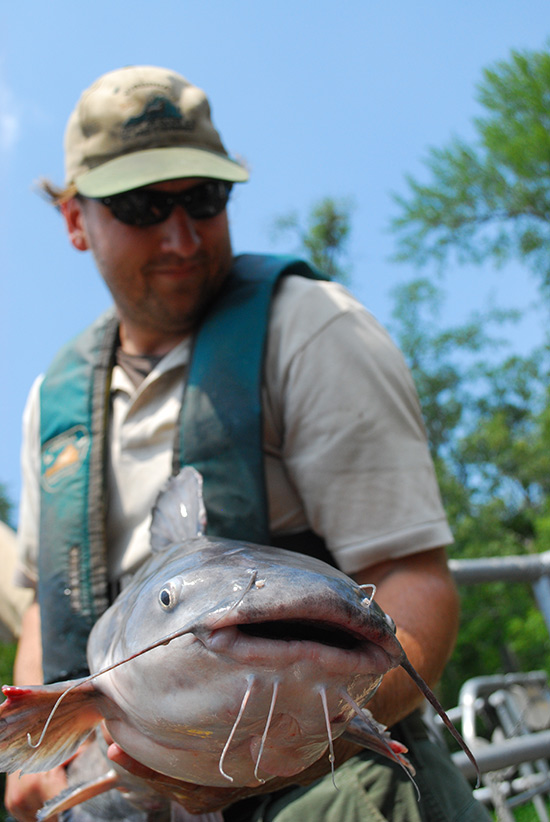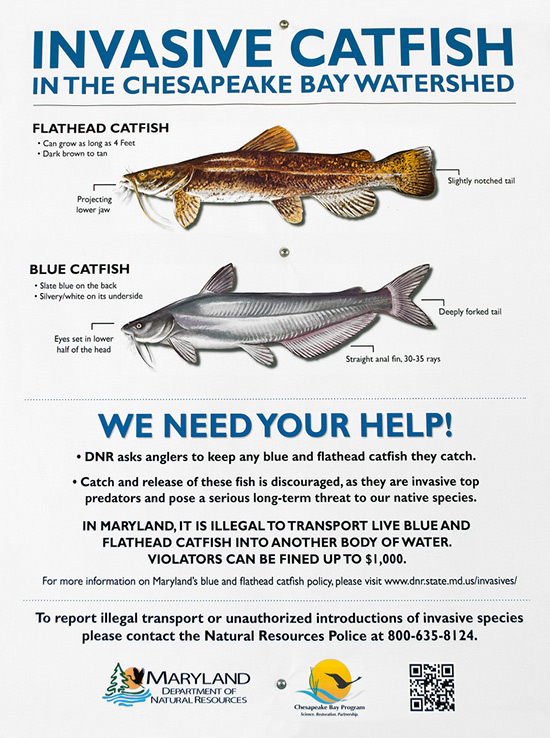Anglers asked to remove invasive catfish from Maryland, Virginia waters
A new outreach campaign will teach citizens about blue and flathead catfish.
The Maryland Department of Natural Resources (DNR) has launched a state-wide campaign to teach citizens about the impact of blue and flathead catfish and encourage anglers to remove the invasive species from local rivers and streams.

Native to the Mississippi, Missouri and Ohio river basins, blue catfish were introduced to the James, Rappahannock and York rivers in the 1970s and ‘80s as a sport fish. Flathead catfish were introduced to the James in the 1960s for the same reason. Over time, the natural movement and purposeful introduction of the fish into new waters have hastened their establishment in Chesapeake Bay tributaries.
This concerns scientists, who fear the fast-growing and long-lived blue catfish, in particular, could impact the region’s ecologic and economic resources. Because of its opportunistic feeding habits, the blue catfish has become an apex predator, disrupting the structure of the Bay ecosystem and eating up critical aquatic species.
Indeed, “gut content analyses” of the fish have found American shad, Atlantic menhaden, freshwater mussels and blue crabs in their stomachs. Peyton Robertson, director of the National Oceanic and Atmospheric Administration’s Chesapeake Bay Office and chair of the Chesapeake Bay Program’s Sustainable Fisheries Goal Implementation Team, compared the blue catfish to a Bengal tiger, noting that the fish eats “just about anything.”
“If left unchecked, [blue catfish] could, as top predators, start to impact other parts of our ecosystem,” Robertson said.

But its eradication isn’t feasible, and experts believe the invasive fish is here to stay. So managers hope to mitigate their spread and minimize their impact on native fish.
With support from the Bay Program, DNR has established more than 150 signs at water access points and kiosks around the state to help anglers identify, catch and keep the species, while Maryland Seafood has escalated its efforts to market the fish to restaurants and boost consumer demand.
“[Humans] are great at overfishing things,” said Maryland Seafood Marketing Director Steve Vilnit. “And [the blue catfish] is a species that we want to overfish.”
From the Field: Monitoring Blue Catfish in Virginia's James River from Chesapeake Bay Program on Vimeo.
In 2012, the Sustainable Fisheries Goal Implementation Team established an Invasive Catfish Task Force, which has drafted seven recommendations to help manage both blue and flathead catfish.

Comments
Why can't these fish be shocked and placed on trucks and put into San Diego lakes. We would love to have them. There are many California lake that would love to have them.
Is there any way to get rid of the Blue Catfish?
Hey, aren't these fish loaded with pcbs and Mercury? Isn't it a little irresponsible to try to increase consumption of these contaminated fish?
Hi Alexis! You can find information on the creel and length limits for these catfish (as well as other fish!) on the Maryland e-regulations website (http://www.eregulations.com/maryland/fishing/) and the Virginia Department of Game and Inland Fisheries website (http://www.dgif.virginia.gov/fishing/regulations/game.asp).
How many of these fish are anglers allowed to keep per day? And does the size of the fish matter? Thank you!!
where can you catch these catfish in terms of rivers that are brackish?
Thank you!
Your comment has been received. Before it can be published, the comment will be reviewed by our team to ensure it adheres with our rules of engagement.
Back to recent stories